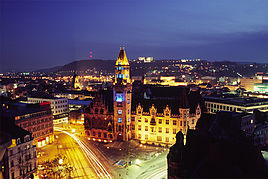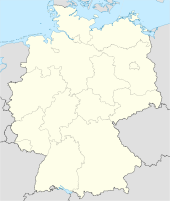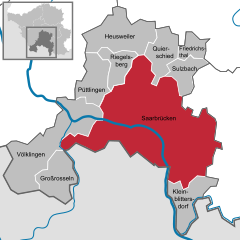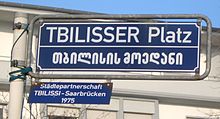- Saarbrücken
-
The title of this article contains the character ü. Where it is unavailable or not desired, the name may be represented as Saarbruecken.
Saarbrücken 
Coordinates 49°14′0″N 7°0′0″E / 49.233333°N 7°ECoordinates: 49°14′0″N 7°0′0″E / 49.233333°N 7°E Administration Country Germany State Saarland District Saarbrücken City subdivisions 20 Mayor Charlotte Britz (SPD) Basic statistics Area 167.07 km2 (64.51 sq mi) Elevation 230.1 m (755 ft) Population 175,741 (31 December 2010)[1] - Density 1,052 /km2 (2,724 /sq mi) Other information Time zone CET/CEST (UTC+1/+2) Licence plate SB Postal codes 66001–66133 Area codes 0681, 06893, 06897, 06898, 06805 Website www.saarbruecken.de County of Saarbrücken
Grafschaft Saarbrücken (de)
Comté de Sarrebruck (fr)
Grofschaft Saarbrécken (lb)State of the Holy Roman Empire ← 
ca 1120–1797  →
→Coat of arms
Capital Saarbrücken Language(s) Rhine Franconian; see language of the Saarland Government Principality Historical era Middle Ages - Joined the Holy
Roman Empire
925- Gained Imp. immediacy ca 1120 - To Nassau-Weilburg 1353 - Occupied by France 1793 - Annexed by France 1797 - Passed to Prussian
Grd Dchy Lwr Rhine
9 June 1815Saarbrücken (German pronunciation: [zaːɐ̯ˈbʁʏkən]; French: Sarrebruck, IPA: [saʁbʁyk]) is the capital of the state of Saarland in Germany. The city is situated at the heart of a metropolitan area that borders on the west on Dillingen and to the north-east on Neunkirchen, where most of the people of the Saarland live.
Saarbrücken used to be the industrial and transport centre of a great coal basin. Production included iron and steel, sugar, beer, pottery, optical instruments, machinery, and construction materials. However, over the past decades the industrial importance of Saarland has declined, as the mining industry has become unprofitable.
Historic landmarks in the city include the stone bridge across the Saar (1546), the Gothic church of St Arnual, the 18th century Saarbrücker Schloss (castle) and the old part of the town, the St. Johanner Markt. In 1815 Saarbrücken came under Prussian control, and for two periods in the 20th century (1919–35 and 1945–57) it became part of the Saar territory under French administration. For this reason, coupled with its proximity to the French border, it retains a certain French influence.
In modern German Saarbrücken literally means Saar bridges, and indeed there are about a dozen bridges across the Saar river. However, the name actually predates any bridge at this spot by at least 500 years. The historical name of the town is actually Sarabrucca, derived from the Old High German word Brucca, which became Brocken in High German (rock or boulder in English).
Contents
History
Roman Empire
The Saar area was incorporated into the Roman Empire in the 1st century BC, and later came under the control of the Franks. In 925 it became part of the Holy Roman Empire.
Middle Ages to 18th century
From 1381 to 1793 the counts of Nassau-Saarbrücken were the main local rulers. Often a prize contended for by its stronger neighbours, the area came under French domination in the 16th century and was incorporated into France in the 1680s. France was forced to relinquish the Saar in 1697, but from 1793 to 1815 regained control of the region.
19th century
After 1815 much of the area was part of the Prussian Rhine Province. During the 19th century the coal and iron resources of the region were developed. At the start of the Franco-Prussian War the area was the first target of the French invasion force, and was occupied between 2 and 4 August 1870, during this war.
20th century
Under the Treaty of Versailles (1919), the Saar coal mines were made the exclusive property of France for a period of 15 years as compensation for the destruction of French mines during the First World War. The treaty also provided for a plebiscite, at the end of the 15-year period, to determine the territory's future status, and in 1935 more than 90% of the electorate voted for reunification with Germany, while only 0.8% voted for unification with France. The remainder wanted to rejoin Germany but not while the Nazis were in power. This 'status quo' group voted for maintenance of the League of Nations administration. The Saar subsequently rejoined Germany.
World War II
Heavily bombed in World War II and made part of the French Zone of Occupation in 1945, the area was made a separate zone in 1946. In 1947, France created the nominally–politically-independent Saar protectorate and merged it economically with France in order to exploit the area's vast coal reserves. Political pressure on France by West Germany and others, as well as the 1955 rejection by the Saarlanders of the compromise solution of Europeanisation of the area, led to the 1 January 1957 political reunion with the Federal Republic of Germany. Economic reintegration would however take many additional years.
Infrastructure
The city is served by the Saarbrücken Airport (SCN) and starting in June 2007 ICE high speed train services along the LGV Est line provide high speed connections to Paris from Saarbrücken Hauptbahnhof. Uniquely, Saarbrücken's "Saarbahn" (modelled on the Karlsruhe model light rail) crosses the French–German border, connecting to the French city of Sarreguemines
Saarbrücken is also the home of the main campus of Saarland University (Universität des Saarlandes). Co-located with the University are several research centres including:
- the Max Planck Institute for Informatics,
- the Max Planck Institute for Software Systems,
- the Helmholtz Institute for Pharmaceutical Research Saarland (HIPS),
- the Fraunhofer Institute for Non-destructive Testing,
- the German Research Centre for Artificial Intelligence,
- the Center for Bioinformatics,
- the Europa Institute,
- the Botanischer Garten der Universität des Saarlandes (a botanical garden) and
- the Korea Institute of Science and Technology Europe Research Society.
Geography
Climate
Saarbrücken Climate chart (explanation) J F M A M J J A S O N D 543−1424−1389−238134461884921115023134023133919105214759726140Average max. and min. temperatures in °C Precipitation totals in mm Source: worldweather.org 2007-12-01 Imperial conversion J F M A M J J A S O N D 2.137301.739301.548281.555391.864461.97052273551.673551.56650257452.345362.43932Average max. and min. temperatures in °F Precipitation totals in inches Region
Some of the closest big cities are Trier, Luxembourg, Nancy, Metz, Kaiserslautern, Karlsruhe and Mannheim. Saarbrücken is also connected by the city's public transport network to the town of Sarreguemines in France, allowing easy crossing of the border between one country and the other. It is also connected to the satellite town of Völklingen, where the old steel works were the first industrial monument to be declared a World Heritage Site by UNESCO in 1994 — the Völklinger Hütte.
International relations
Saarbrücken is a fellow member of the QuattroPole union of cities, along with Luxembourg, Metz, and Trier (neighbouring countries: Luxembourg and France).
Twin towns – Sister cities
Saarbrücken is twinned with:
Famous people
- Peter Kurtz (11 November 1881 – 10 October 1977), Native Son of Saarbrücken, Germany., Introduced the Music of Peer Gynt to America
- Max Ophüls (6 May 1902 - 25 March 1957), film director
- Wolfgang Staudte (9 October 1906 - 19 January 1984), film director
- Walter Schellenberg (16 January 1910 – 31 March 1952), German Nazi (head of Foreign intelligence)
- Gerhard Schröder (11 September 1910 - 31 December 1989), politician
- Otto Steinert (12 July 1915 – 3 March 1978), photographer
- Frederic Vester (23 November 1925 - 2 November 2003), biochemist
- Frédéric Back (8 April 1924), Canadian animator
- Hannelore Baron (8 June 1926 - 28 April 1987), collage and assemblage artist, emigrated to United States in 1941.
- Tzvi Avni (2 September 1927), Israeli composer
- Sandra Cretu (18 May 1962), singer
- Claudia Kohde-Kilsch (11 December 1963), tennis player
- Nicole (25 October 1964), singer
- Manfred Trenz (29 November 1965), game designer
- Andreas Escher (23 January 1966), game designer
Honorary citizen
- Willi Graf (2 January 1918 - 12 October 1943), member of the White Rose resistance group
- Richard Becker (Politiker) (10 October 1884 - 11 April 1969), Politician and Businessman
Gallery
-
The Ludwigskirche (Ludwig Church)
-
The campus of the Saarland University
References
- Notes
- ^ "Fläche, Bevölkerung in den Gemeinden am 31.12.2010 nach Geschlecht, Einwohner je km² und Anteil an der Gesamtbevölkerung" (in German). Statistisches Amt des Saarlandes. 31 December 2010. http://www.saarland.de/dokumente/thema_statistik/staa_FB311209.pdf.
- ^ "Tbilisi Municipal Portal - Sister Cities". © 2009 - Tbilisi City Hall. http://www.tbilisi.gov.ge/index.php?lang_id=ENG&sec_id=4571. Retrieved 2009-06-16.
External links
 Capitals of states of the Federal Republic of Germany
Capitals of states of the Federal Republic of GermanyCapitals of area states Dresden (Saxony) • Düsseldorf (North Rhine-Westphalia) • Erfurt (Thuringia) • Hanover (Lower Saxony) • Kiel (Schleswig-Holstein) • Magdeburg (Saxony-Anhalt) • Mainz (Rhineland-Palatinate) • Munich (Bavaria) • Potsdam (Brandenburg) • Saarbrücken (Saarland) • Schwerin (Mecklenburg-Vorpommern) • Stuttgart (Baden-Württemberg) • Wiesbaden (Hesse)
Citystates1 Capitals of former states Freiburg im Breisgau (South Baden, 1949–1952) • Stuttgart (Württemberg-Baden, 1949–1952) • Tübingen (Württemberg-Hohenzollern, 1949–1952)
1 Unlike the mono-city states Berlin and Hamburg the State of Bremen consists of two cities, thus state and capital are not identical.Cities in Germany by population 1,000,000+ 500,000+ 200,000+ Aachen · Augsburg · Bielefeld · Bochum · Bonn · Braunschweig · Chemnitz · Duisburg · Erfurt · Freiburg im Breisgau · Gelsenkirchen · Halle an der Saale · Karlsruhe · Kiel · Krefeld · Lübeck · Magdeburg · Mannheim · Münster · Mönchengladbach · Oberhausen · Rostock · Wiesbaden · Wuppertal
100,000+ Bergisch Gladbach · Bottrop · Bremerhaven · Cottbus · Darmstadt · Erlangen · Fürth · Göttingen · Hagen · Hamm · Heidelberg · Heilbronn · Herne · Hildesheim · Ingolstadt · Jena · Kassel · Koblenz · Leverkusen · Ludwigshafen · Mainz · Moers · Mülheim an der Ruhr · Neuss · Offenbach am Main · Oldenburg · Osnabrück · Paderborn · Pforzheim · Potsdam · Recklinghausen · Regensburg · Remscheid · Reutlingen · Saarbrücken · Salzgitter · Siegen · Solingen · Trier · Ulm · Wolfsburg · Würzburg
Friedrichsthal | Großrosseln | Heusweiler | Kleinblittersdorf | Püttlingen | Quierschied | Riegelsberg | Saarbrücken | Sulzbach | Völklingen Categories:
Categories:- Cities in Saarland
- Former principalities
- Former countries in Europe
- States of the Holy Roman Empire
- States and territories established in the 12th century
- States and territories disestablished in 1797
- 1797 disestablishments
- Saarbrücken
- German state capitals
- Towns in Saarland
Wikimedia Foundation. 2010.



















